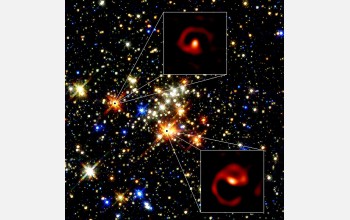News Release 06-118
Stellar Pinwheels at Our Galaxy's Core
Mystery Quintuplets' Identity Crisis Resolved
August 18, 2006
This material is available primarily for archival purposes. Telephone numbers or other contact information may be out of date; please see current contact information at media contacts.
Astronomers have finally learned the identity of a mysterious "Quintuplet Cluster" of stars situated near the supermassive black hole at our galaxy's core: At least two of the objects are not individual stars, but binary pairs that live fast and die young, forming fiery pinwheels as they spin around one another.
A multinational team led by Peter Tuthill of the University of Sydney in Australia, used the extraordinary resolution of the 10-meter telescope at the W.M. Keck Observatory in Hawaii, to determine the nature of the enigmatic objects. They report their findings in the Aug. 18 issue of the journal Science.
Until these observations, researchers had not known whether the extremely red "cocoon" quintuplets were aging stars surrounded by shells of dust, or young stars accompanied by disks of bright gas. Neither hypothesis was convincing, and neither fully explained the enormous light output: Each quintuplet emits 10,000 to 100,000 times as much radiation as the Sun.
The new findings indicate the quintuplets are members of a rare class called "Wolf-Rayet colliding-wind binaries" -- massive, fast-burning star pairs that live only a few million years before exploding in terminal supernovae. By contrast, the Sun is about 5 billion years old and only middle-aged. The pinwheel effect is caused by the way each star's dusty mantle is affected by that of its partner, producing spiral plumes.
"The discovery of spiral plumes, the size of our entire solar system, has solved the enigma of the bright red stars in the Quintuplet Cluster located right next door (within 100 light-years) to the center of our Galaxy," says study co-author Andrea Ghez of the University of California, Los Angeles. "Within the astronomy world, there has been a surge of interest in these stars. Wolf-Rayets are very massive stars at the very end-point of their normal lives: they are the last stable phase before a supernova explosion. Massive binary systems such as these pinwheel stars will, in fact, explode three times: two explosions as each of the pair separately undergoes a core-collapse supernova, then a third explosion as the two fall into each other in an inspiral-merger event -- possibly in the quite-distant future."
The team also included researchers from the University of Michigan, the Jet Propulsion Laboratory at Caltech, Rochester Institute of Technology (RIT) and NASA's Goddard Space Flight Center. The research was funded by the Australian Research Council and the National Science Foundation's astronomy division.
For more information, see the RIT news release.
-NSF-
Media Contacts
Curt Suplee, NSF, (703) 292-8070, email: csuplee@nsf.gov
Susan Gawlowicz, Rochester Institute of Technology, (585) 475-5061, email: smguns@rit.edu
The U.S. National Science Foundation propels the nation forward by advancing fundamental research in all fields of science and engineering. NSF supports research and people by providing facilities, instruments and funding to support their ingenuity and sustain the U.S. as a global leader in research and innovation. With a fiscal year 2023 budget of $9.5 billion, NSF funds reach all 50 states through grants to nearly 2,000 colleges, universities and institutions. Each year, NSF receives more than 40,000 competitive proposals and makes about 11,000 new awards. Those awards include support for cooperative research with industry, Arctic and Antarctic research and operations, and U.S. participation in international scientific efforts.
Connect with us online
NSF website: nsf.gov
NSF News: nsf.gov/news
For News Media: nsf.gov/news/newsroom
Statistics: nsf.gov/statistics/
Awards database: nsf.gov/awardsearch/
Follow us on social
Twitter: twitter.com/NSF
Facebook: facebook.com/US.NSF
Instagram: instagram.com/nsfgov



